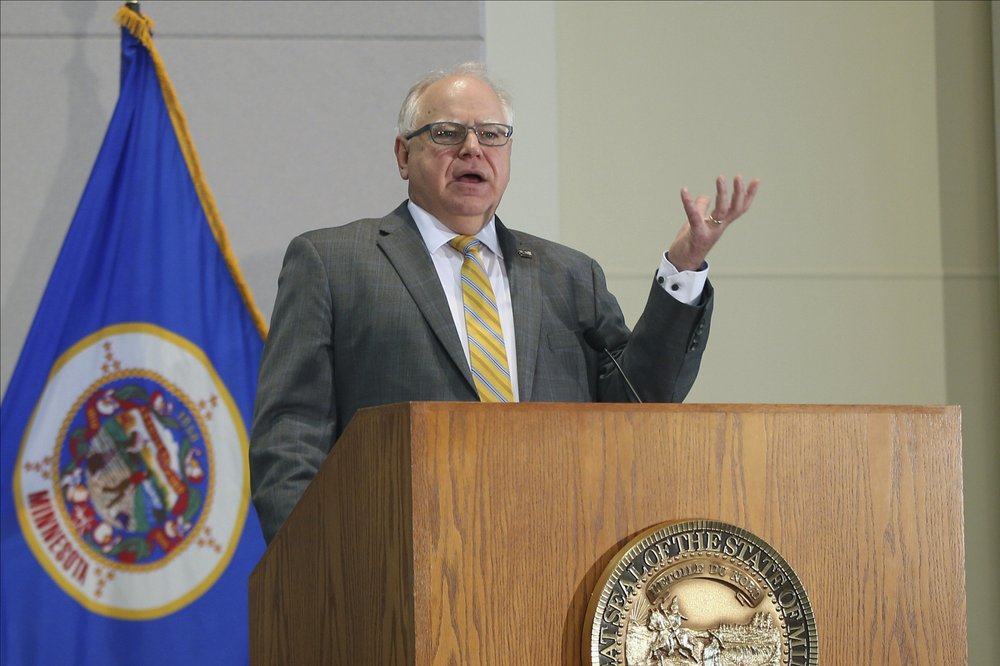Minnesota
Minnesota’s surprising surplus spurs talks on virus aid plan

MINNEAPOLIS (AP) — Minnesota is facing a surprising $641 million projected surplus in its current budget, which makes money available for a new coronavirus relief package, but officials cautioned Tuesday that the state is still facing a $1.3 billion shortfall for its next budget.
The not-so-bad projections from Minnesota Management and Budget came as a welcome turnaround from the agency’s last forecast, which was released in May. Back then, it projected a $2.4 billion deficit in the current budget cycle and a $4.7 billion shortfall in the next.
The new forecast is expected to spur negotiations among Gov. Tim Walz and legislative leaders from both parties on an aid package targeted at struggling small businesses — and possibly workers and families — that lawmakers could approve in a special session sometime this month.
“I still think there’s every reasonable opportunity that we get this thing done in the next week or so. We have the numbers now,” the Democratic governor said at a news conference after the projections came out. He said he’s ready for a compromise that won’t look exactly like his own plan. But he added that he’s not feeling any GOP pushback so far, though Republicans control the Senate.
Walz and Democrats who control the House teamed up to announce one proposal last week while House Republicans offered another. Both are aimed at easing the pain of the four-week closure on bars, restaurants and gyms and other restrictions that he imposed in response to the spike in COVID-19. Walz hinted Tuesday that he may extend those restrictions past the Dec. 18 expiration date.
MMB Commissioner Jim Schowalter and other budget officials said at a briefing that the updated projections are better than May’s partly because tax revenues are running higher than expected. Consumers are shifting their spending amid the pandemic away from services affected by social distancing that aren’t subject to the sales tax, and they’re buying more taxable goods such as electronics and furniture. And the blow to income tax collections was less than expected because lower-income workers, who don’t pay as much in taxes, suffered the most from the downturn.
At the same time, they said, spending on health and human services and education fell. Public school enrollment dropped by about 8,000 more students than expected due to families delaying kindergarten or opting for private schools or home schooling. And the federal government picked up a bigger share of Medical Assistance costs than earlier expected.
“We know that the pandemic has affected all Minnesotans, bringing with it a discouraging run of events and news, especially for lower-wage workers where the economic impact has been concentrated,” Schowalter said. “We still have challenges ahead. But this budget and revenue forecast brings a bit of good news to the state.”
The aid package from Walz and House Democrats includes a 13-week extension of unemployment insurance benefits and $500 one-time payments to low-income families that participate in the Minnesota Family Investment Program. The original House GOP plan did not, though Republican House Minority Leader Kurt Daudt, of Crown, told reporters they support extending jobless benefits. GOP Rep. Pat Garofalo, of Farmington, said they want to keep the focus on small businesses.
Democratic House Majority Leader Ryan Winkler told reporters there have been relatively few sticking points in talks between House Democrats and Republicans and Senate Democrats. He said the holdup has been that Senate Republican leaders have not been engaged so far. “Hopefully the forecast frees them up to come to the table with some ideas about what they would like to do,” he said.
The projected $1.3 billion shortfall for the next two-year budget, which takes effect July 1, is relatively small compared with an overall budget that’s likely to come in around the $50 billion range. Assembling that budget, which will be based on a fresh economic forecast in February, will be the main work of the 2021 legislative session, which opens Jan. 5.
Senate Republican leaders did not hold a news conference to take questions on the new forecast. They issued just short video statements instead from Majority Leader Paul Gazelka, of East Gull Lake, and Finance Committee Chairwoman Julie Rosen, of Vernon Center. They said the new projections show that state government doesn’t need to raise taxes but it does need to control spending. They didn’t comment on the aid package negotiations.

